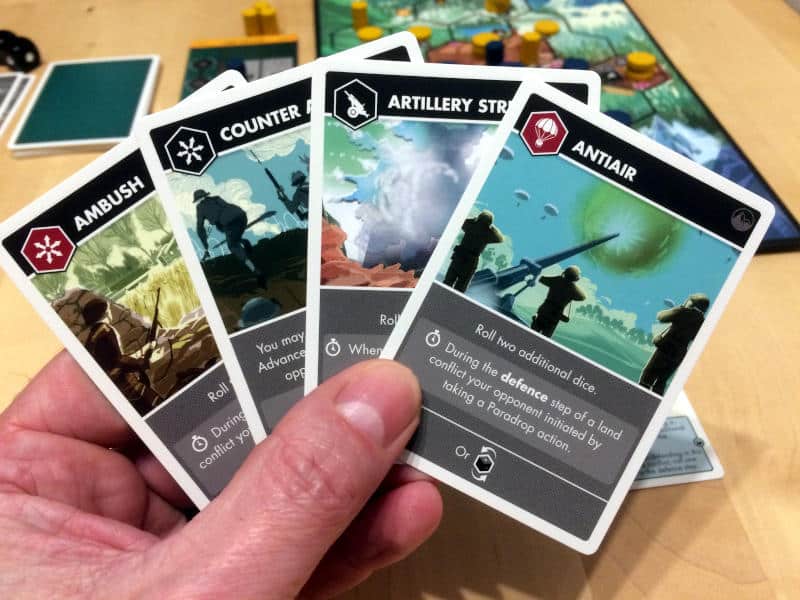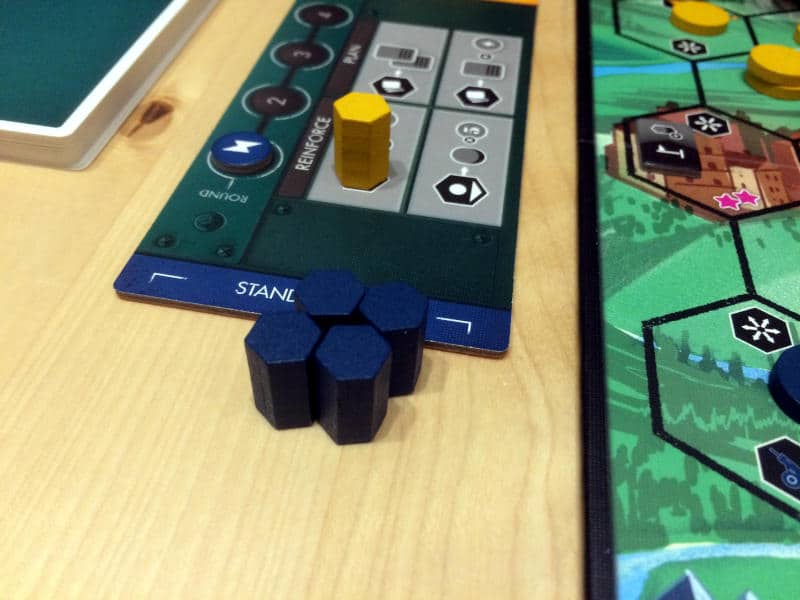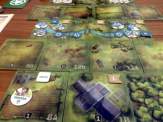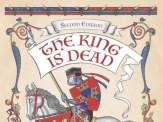| Release Date: 2023 | Players: 2 (only) |
| Designer: David Thompson, Trevor Benjamin | Length: 30-45 minutes |
| Artist: Alex Green | Age: 12+ |
| Publisher: Osprey Games | Complexity: 2.0 / 5 |
| Plastic (by weight): < 1% | Air (by volume): 25% |
The mountains provided great vantage points for both sides. We could easily see what the enemy was doing, but so could they. Providing air support was going to be impossible because of the terrain, but we were still considering paradrops to get troops far into the enemy’s territory. It would all come down to tactics, because we had only been given General Orders: World War II by Trevor Benjamin and David Thompson from Osprey Games.
Listen to the Audio Version
Intro Music: Bomber (Sting) by Riot (https://www.
Sound Effects: bbc.co.uk – © copyright 2024 BBC
Music: “Heroes” by AShamaluevMusic.
Website: https://www.
Music: “Hope” by AShamaluevMusic.
Website: https://www.
Music: “Valiant” by AShamaluevMusic.
Website: https://www.
Generally Undaunted
Maybe my introduction is a little misleading. General Orders, as I will call the game for short, is not an historic simulation. As the rulebook says at the back, “whilst actions and settings are historically based, […] the core mechanic of worker placement is an obvious abstraction from the choices available to generals at the time.” To be honest, when you play General Orders it feels much more like an abstract two-player strategy game. So while the setting is a natural fit for the goals players have and the types of actions they can take, the game engine would work just as well in a fantasy setting or in some other historical or fictional confrontation.
In that sense, the game reminds me very much of Undaunted: Normandy, another game by the same designer duo. Both, General Orders and Undaunted give players a set of mechanisms that are pretty easy to learn and understand and that allow for varied and interesting gameplay with huge depth that can be applied to a wide range of settings and scenarios.
However, both game engines function quite differently, of course. While Undaunted is very much a deck-building card-driven type of game, General Orders is all about action selection. While each scenario in the Undaunted series can take an hour or two to play, General Orders is hugely streamlined and easily plays in half an hour. Yet, both games execute what they do to perfection.
You can see how the designers wanted to create something that was as simple to learn as Undaunted, but would fit into a much tighter, faster game experience where every decision mattered. If that is indeed what they were trying to do, they have certainly achieved it.

Get yourself a wooden Tabletop Games Blog dice tray.
Each tray is the perfect size to roll your dice, and with the soft mat, it’s really quiet, while the wooden frame makes it wonderfully sturdy.
Action Selection Area Control
In General Orders, you place your hexagonal commander tokens onto action spots either on the map or on a separate board. With these actions, you can drop some of your troops behind enemy lines or fire your cannon to pummel an opponent’s positions. You can also advance your troop discs towards the opponent’s headquarters and then reinforce them to strengthen your control on the map that is divided into hex spaces, some of which are joined into one area. Of course, while it would be great to march into the opponent’s base and end the game, it’s more likely that you get bogged down in the centre of the board, vying for control of special spaces that enhance certain actions.
Actions also allow you to draw cards, which give you one-off benefits. These allow you to defend yourself, increase your attack strength or otherwise enhance your actions. These cards can be crucial for victory or when you need to reroll dice during conflict resolution. Oh yes, conflict resolution is a simple matter of rolling dice and removing discs until only one player is left in the contested hex.
In fact, the whole game is really simple. Players take turns placing one of their commander tokens, carrying out the relevant actions, resolving conflicts or playing cards. Yet, every decision absolutely counts. Players have only four commander tokens, meaning four actions per round and the game ends after the fourth round at the latest. That’s sixteen actions in total, which is just enough to ensure General Orders is over as it reaches its climax. If anything, it feels like it’s over sooner than you’d like it to. So the game definitely doesn’t outstay its welcome.

Tight, Tighter, Tightest
That’s what excites me most about General Orders: how tight it all is. It starts peacefully enough, but soon you and your enemy crowd the map and lay claim to the central hexes. You have little skirmishes until eventually, the big guns lay waste to your enemy’s position. However, before you get a chance to take advantage of a gap in your enemy’s lines, you are yourself at risk of being overrun. So you reinforce your troops and block off the attack the best you can, when suddenly the game is over and whoever has control of the most point spaces wins.
It is really impressive. When you first play General Orders, it’s easy to assume the game will be over too quickly before any meaningful actions can take place. Equally, you might expect the game to last ages and end in a drawn-out quagmire of minimal gains and hardly any movement. Yet, you’d be wrong on both counts.
The game is so tightly designed that you will always get to a point where both players are ready to claim victory, when one gets enough of an advantage to be able to win, only for the other player to take back control and clinch the crucial hexes on their last turn. General Orders ends at exactly the right moment, there is no doubt about that.
In fact, given that each game will take around 30 minutes to play, except maybe your first one, you can easily play two or three in one night. So if anyone thinks luck wasn’t on their side, then you can go for a best of three without any problems.
Luck Mitigation
Yet, I really don’t think luck is ever the deciding factor in General Orders. Yes, there are dice rolls that decide who wins a conflict. Players draw cards from a shuffled deck, so it is possible that you just don’t get the cards you need. However, there is never anything stopping you from drawing more cards to even out the luck of the draw. You can also reinforce your troops to make dice rolls almost pointless, because of the sheer force you have present.
Of course, you do have to consider whether taking actions to draw more cards or reinforce your troops is the right decision. It may well be better to simply force yourself deeper into the enemy’s territory and fight them on several fronts, creating chaos and mayhem in the process. It really is up to you to choose how you want to play General Orders and what tactics you prefer. You can trust your luck to dice or cards just as well as you can to cleverly outmanoeuvring your opponent on the battlefield. You can also block off an action space that is vitally important to your opponent by placing your own token there. However, that action may be wasteful to you.
That’s what makes the game so wonderfully exciting. Literally, every time you place your commander token you need to make a hugely important decision. Get it wrong once and you might be able to recover. Get it wrong twice and unless your opponent is asleep at the wheel, you will really struggle. Yet, if you have the right cards, you can still turn it all around.

General Standing Orders
General Orders is such a delicious game. The action selection engine and tight action economy make for an amazingly deep and exhilarating experience. While the game comes with two maps, one will definitely keep you enthralled for many, many games. However, if you want to buzz around the sky with planes, you definitely can. I found playing just the mountain map enough for my purposes, but of course, the choice is yours.
One last thing is the size of the box. It’s pretty small, but perfectly formed. It’s the same size as Village Rails and is filled with a deck of cards, wooden troop and commander tokens, the thick main game board and the equally thick support board and the tiny rulebook. The game doesn’t take up much room on the table and is easy to teach and quick to learn. It’s the perfect game you can take with you almost anywhere.
So, I don’t want to tell you what to do, but I’d like to give you some General Orders.
This blog is free for everyone, but if you'd like to support it, here are some options.
Useful Links
- General Orders: https://www.
ospreypublishing. com/ uk/ general-orders-world-war-ii-9781472859860/ - Rulebook: https://boardgamegeek.
com/ filepage/ 262684/ general-orders-world-war-ii-rulebook - Osprey Games: https://www.
ospreypublishing. com/ uk/ osprey-games/ - BGG listing: https://boardgamegeek.
com/ boardgame/ 381435/ general-orders-world-war-ii - Undaunted: Normandy review: https://tabletopgamesblog.
com/ 2022/ 07/ 23/ undaunted-normandy-saturday-review/ - Village Rails review: https://tabletopgamesblog.
com/ 2023/ 03/ 11/ village-rails-saturday-review/
Videos
Transparency Facts
I feel that this review reflects my own, independent and honest opinion, but the facts below allow you to decide whether you think that I was influenced in any way. Please also read my Ethics Statement for more information.- I played a friend's copy of the game.
- At the time of writing, I have not received financial support from the publisher or anyone working on their behalf.
Audio Version
Intro Music: Bomber (Sting) by Riot (https://www.
Sound Effects: bbc.co.uk – © copyright 2024 BBC
Music: “Heroes” by AShamaluevMusic.
Website: https://www.
Music: “Hope” by AShamaluevMusic.
Website: https://www.
Music: “Valiant” by AShamaluevMusic.
Website: https://www.
Playlist
These are the songs I listened to while I was writing this review:





